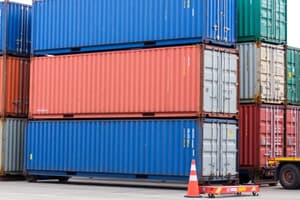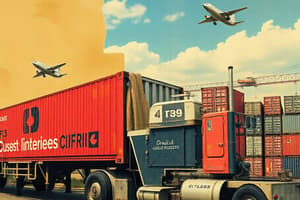Podcast
Questions and Answers
How does an intermodal transport node differ from a unimodal transport node?
How does an intermodal transport node differ from a unimodal transport node?
- An intermodal transport node is always located in high-density residential areas, while a unimodal transport node is not.
- An intermodal transport node primarily serves tourist destinations, while a unimodal transport node caters to local commuters.
- An intermodal transport node focuses on environmental sustainability, while a unimodal transport node prioritizes capacity.
- An intermodal transport node offers opportunities to switch between routes, while a unimodal transport node does not. (correct)
What factors are considered when evaluating the convenience of a transport network?
What factors are considered when evaluating the convenience of a transport network?
- The capacity of vehicles and the frequency of maintenance.
- The number of workplaces accessible via the network and the frequency of routes to tourist destinations.
- The environmental sustainability of the transport mode and the population density of the area served.
- The availability of barrier-free access and ease of transferring between modes. (correct)
In the context of Singapore's food import trends, what elements should be included in an analysis of spatial distribution of intermodal transport nodes?
In the context of Singapore's food import trends, what elements should be included in an analysis of spatial distribution of intermodal transport nodes?
- General trends for major food exporters, supporting evidence, contrasting trends from smaller exporters, and noteworthy exceptions. (correct)
- Historical data on food prices and their correlation with transportation costs.
- Specific routes used by food delivery services and their impact on road congestion.
- A detailed breakdown of the types of food imported and their nutritional value.
Which of the following best describes how high population density influences the development of intermodal transport nodes?
Which of the following best describes how high population density influences the development of intermodal transport nodes?
Why are important amenities like hospitals and governmental agencies key factors in the development of intermodal transport nodes?
Why are important amenities like hospitals and governmental agencies key factors in the development of intermodal transport nodes?
How does the expansion of office workspaces in an area influence the need for intermodal transport nodes?
How does the expansion of office workspaces in an area influence the need for intermodal transport nodes?
What is one of the primary human impacts of deforestation resulting from the development of transport infrastructure?
What is one of the primary human impacts of deforestation resulting from the development of transport infrastructure?
What is one of the environmental impacts of deforestation caused by transport infrastructure development?
What is one of the environmental impacts of deforestation caused by transport infrastructure development?
Why are crowded transport nodes considered potential targets for terrorism?
Why are crowded transport nodes considered potential targets for terrorism?
What are the potential human impacts of traffic congestion in cities?
What are the potential human impacts of traffic congestion in cities?
What is one of the environmental impacts associated with traffic congestion and the release of PM2.5 particles?
What is one of the environmental impacts associated with traffic congestion and the release of PM2.5 particles?
How does the Certificate of Entitlement (COE) policy in Singapore aim to promote environmental sustainability?
How does the Certificate of Entitlement (COE) policy in Singapore aim to promote environmental sustainability?
What are some limitations of promoting cycling as a sustainable transportation option, as seen in Singapore?
What are some limitations of promoting cycling as a sustainable transportation option, as seen in Singapore?
How do electric vehicles (EVs) contribute to environmental sustainability in public transportation?
How do electric vehicles (EVs) contribute to environmental sustainability in public transportation?
What are some reasons for the low acceptance of electric vehicles (EVs) in certain regions, such as India?
What are some reasons for the low acceptance of electric vehicles (EVs) in certain regions, such as India?
Which of the following factors is most likely to influence the decision to develop an intermodal transport node in a specific location?
Which of the following factors is most likely to influence the decision to develop an intermodal transport node in a specific location?
How might increased accessibility to tourist destinations influence the development of intermodal transport nodes?
How might increased accessibility to tourist destinations influence the development of intermodal transport nodes?
In what ways does the disruption of public transport due to terrorist attacks affect residents?
In what ways does the disruption of public transport due to terrorist attacks affect residents?
What is a significant environmental consequence of traffic congestion, besides air pollution?
What is a significant environmental consequence of traffic congestion, besides air pollution?
Why might legislation aimed at promoting cycling face limitations in achieving its goals?
Why might legislation aimed at promoting cycling face limitations in achieving its goals?
In what ways does traffic congestion contribute to human health problems?
In what ways does traffic congestion contribute to human health problems?
How does the promotion of electric vehicles contribute to managing transport systems sustainably?
How does the promotion of electric vehicles contribute to managing transport systems sustainably?
What is the primary reason for the deforestation that occurs due to transport infrastructure development?
What is the primary reason for the deforestation that occurs due to transport infrastructure development?
Which of the following is a direct human impact associated with transport-related air pollution?
Which of the following is a direct human impact associated with transport-related air pollution?
How can promoting the use of electric vehicles (EVs) assist in mitigating global warming?
How can promoting the use of electric vehicles (EVs) assist in mitigating global warming?
What is a key limitation when implementing legislation, like expanding the cycling network, to encourage sustainable transportation?
What is a key limitation when implementing legislation, like expanding the cycling network, to encourage sustainable transportation?
How can improving intermodal transport nodes potentially reduce the environmental impacts of transportation?
How can improving intermodal transport nodes potentially reduce the environmental impacts of transportation?
Which strategy is most effective in reducing the risks of terrorism in public transportation systems?
Which strategy is most effective in reducing the risks of terrorism in public transportation systems?
What is the most significant impact of replacing forests with roads in the context of urban environments?
What is the most significant impact of replacing forests with roads in the context of urban environments?
What is a significant economic consequence of terrorist attacks on public transportation systems?
What is a significant economic consequence of terrorist attacks on public transportation systems?
Flashcards
Transport Node
Transport Node
A location providing entry to a transportation network.
Intermodal Transport Node
Intermodal Transport Node
A node allowing switches between routes to access more places.
Route
Route
The path of travel between nodes.
Frequency
Frequency
Signup and view all the flashcards
Coverage
Coverage
Signup and view all the flashcards
Convenience
Convenience
Signup and view all the flashcards
Capacity
Capacity
Signup and view all the flashcards
Population Density Impact
Population Density Impact
Signup and view all the flashcards
Amenities Impact
Amenities Impact
Signup and view all the flashcards
Workplaces Impact
Workplaces Impact
Signup and view all the flashcards
Tourist Destination Impact
Tourist Destination Impact
Signup and view all the flashcards
Deforestation
Deforestation
Signup and view all the flashcards
Terrorism Threat
Terrorism Threat
Signup and view all the flashcards
Traffic Congestion
Traffic Congestion
Signup and view all the flashcards
Legislation & Policies
Legislation & Policies
Signup and view all the flashcards
Green Transportation R&D
Green Transportation R&D
Signup and view all the flashcards
Certificate of Entitlement (COE)
Certificate of Entitlement (COE)
Signup and view all the flashcards
Greener Public Transportation
Greener Public Transportation
Signup and view all the flashcards
Active Mobility (Cycling)
Active Mobility (Cycling)
Signup and view all the flashcards
Electric Vehicles (EVs)
Electric Vehicles (EVs)
Signup and view all the flashcards
Study Notes
Nodes & Routes
- Nodes are locations providing entry to a transportation network.
- Unimodal transport nodes limit access to other routes.
- Intermodal transport nodes allow switching between routes to access more places.
- Routes are paths of travel between nodes.
Factors of Transport Networks
- Frequency: Impacts wait time and speed to the destination.
- Environmental Sustainability: Measures the environmental impact of the transport mode.
- Capacity: The number of people/goods that can be moved, impacting network efficiency.
- Coverage: Availability and reach of infrastructure, affecting walking distance and convenience.
- Convenience: Ease of movement, including accessibility for disabled/elderly and ease of transfers/payments.
Spatial Distribution of Intermodal Transport Nodes
- Major food exporters to Singapore may follow a general trend.
- Evidence supports the general trend for major food exporters.
- Contrasting trends may exist with the smallest food exporters.
- Exceptions or noteworthy observations can occur.
- Intermodal transport nodes impact Singaporeans in multiple ways.
- Superficial level, social impacts and economic impacts are all ways Singapore is affected
Population Density & Intermodal Transport Nodes
- High population density can lead to a location becoming an intermodal transport node.
- Jurong East is an example, with a high population density of 4900 people/km².
- Intermodal nodes in high-density areas provide residents with access to more routes and convenient travel options.
Important Amenities & Intermodal Transport Nodes
- Proximity to important amenities can lead to the development of intermodal transport nodes.
- Jurong East has amenities like Ng Teng Fong Hospital and governmental agencies like SEA.
- Intermodal nodes increase the accessibility of these amenities to people from all over Singapore.
Workplaces & Intermodal Transport Nodes
- A greater number of workplaces can result in a location becoming an intermodal transport node.
- Jurong East is developing more office workspace, increasing the number of commuters.
- Intermodal nodes allow people from all over Singapore to conveniently access workplaces.
Tourist Destinations & Intermodal Transport Nodes
- Tourist destinations may become intermodal transport nodes.
- This is done to provide easy access to places of interest.
Impact of Transportation on People & the Environment: Deforestation
- Development of transport infrastructure leads to deforestation.
- The construction of the Bukit Timah Expressway (BKE) in Singapore cleared 15 hectares of primary forest in Bukit Timah Nature Reserve.
Human Impacts of Deforestation
- Replacing forests with roads leads to the urban heat island effect.
- Dark-colored asphalt absorbs heat, increasing the temperature.
- Residents become more vulnerable to heat injuries like heat stroke.
Environmental Impacts of Deforestation
- Deforestation causes a loss in biodiversity.
- The primary rainforest is home to endangered native animals like the Sunda Pangolin.
- Disruption of the ecological cycle threatens the survival of other organisms.
Impact of Transportation on People & the Environment: Terrorism
- Crowded public spaces, like transport nodes, are attractive targets for terrorism.
- In 2016, ISIS suicide bombers detonated bombs in Brussels Airport and a Subway station.
- The bombings resulted in 28 deaths and over 300 injuries.
- Airport operation and subway services ceased operating for more than 36 hours.
- These events resulted in economic losses and disruption to daily routines.
Impact of Transportation on People & the Environment: Traffic Congestion
- Traffic congestion leads to the release of PM2.5 particles.
- In Ho Chi Minh City, Vietnam, PM2.5 levels exceed 14 times the WHO recommended level.
Human Impacts of Traffic Congestion
- PM2.5 particles contain toxic chemicals that can enter the bloodstream.
- Exposure to PM2.5 particles leads to serious health issues like lung cancer and coronary heart disease.
Environmental Impacts of Traffic Congestion
- PM2.5 particles block out sunlight, affecting photosynthesis and leading to plant death.
- Loss of vegetation results in loss of food source and habitat for wildlife. This can threaten endangered species of animals leading to loss of biodiversity.
Sustainable Management via Legislation, Laws & Policies for Transportation
- Laws and policies regulate the use of private cars.
- Singapore's Certificate of Entitlement (COE) policy increases the cost of car ownership.
- The COE has caused a decrease in the number of cars owned in Singapore.
- Encouraging people to use public transport relies on greener vehicles. This reduces greenhouse gases and mitigates global warming.
- Alternatively, reducing cars decreases traffic congestion, which reduces exhaust fumes and PM2.5 particles, improving health and biodiversity.
Limitations (Cycling (Active Mobility)):
- Cycling does not emit greenhouse gases and air pollutants making it a green form of transport.
- Lack of interest in cycling.
- Expanding island-wide cycling network from 2019 to 2024, but the number of Singaporeans choosing to commute with bicycles is still very low at less than 6% of the population in 2024.
- Many cite safety issues and the lack of end-of-trip facilities like shower facilities as reasons why they would not cycle to commute daily .
- A high number of people would still choose to commute using cars or public transport which emits more greenhouse gases and air pollutants compared to cycling which has zero emissions.
- Causes higher carbon emissions leading to global warming, or more PM2.5 from reliance on private transport increasing health and biodiversity risk.
Sustainable Management via Research & Development of Green Transportation
- Technological innovations like electric vehicles (EVs) help promote environmental sustainability.
- EVs have a smaller carbon footprint, produce less noise, and maintain cleaner air quality.
Success (EVs for Public Transportation):
- Expand electric buses to replace older fuel-operated vehicles by 2040
- Reduces carbon emissions and greenhouse gases mitigating global warming.
- Less exhaust fumes means there are lesser PM2.5 particles, therefore benefiting biodiversity and managing health issues while improving air quality.
Limitations (Low Acceptance of EVs in India):
- Adopting rate of EVs remain very low at 7.5% in 2024 due to high retail price and lack of charging ports.
- Continued reliance on gas-powered cars releases more greenhouse gases, causing global warming and increased amounts of PM2.5, causing air pollution.
Question Types
- Identify
- Describe
- Explain
- Compare
- Evaluate Essay
Studying That Suits You
Use AI to generate personalized quizzes and flashcards to suit your learning preferences.





